Ultra-Short-Term Load Forecasting for Customer-Level Integrated Energy Systems Based on Composite VTDS Models
Abstract
:1. Introduction
2. Variational Mode Decomposition
3. t-SNE Data Dimensionality Reduction and FDBSCAN Clustering Noise Reduction
3.1. Data Compression and Dimensionality Reduction Based on the t-SNE Algorithm
3.2. FDBSCAN Clustering Noise Reduction
4. Data Restoration and Data Filling
5. QPSO-Optimized SVR Model
5.1. SVR Model
5.2. QPSO Optimization SVR Model Steps
- (1)
- Data preprocessing. Normalize the time series data containing influencing factors, and divide the processed data into training and testing datasets.
- (2)
- Initialize the quantum particle swarm, such as the swarm size; maximum number of iterations; tolerance errors, ; the range of penalty parameters, C; and Gaussian kernel parameters, .
- (3)
- Set the fitness function for QPSO to be mean square error (MSE).
- (4)
- Calculate the optimal positions for each particle in the particle swarm and the global best position using MSE.
- (5)
- Calculate the average of the optimal positions in the particle swarm and update the particle positions.
- (6)
- Repeat steps (2) to (5) until the iteration termination condition is met, and output the optimized values of .
- (7)
- Perform load forecasting for electrical, cooling, and heating loads.
6. Load Forecasting Method Based on Composite VTDS Model
6.1. General Architecture of Composite VTDS Model
6.2. Evaluation Indicators
- (1)
- RMSE
- (2)
- R2
- (3)
- MAE
7. Calculation Example Analysis
7.1. Experimental Data and Work Platform
7.2. IES Load Decomposition and Data Series Processing
7.3. Results Analysis
- (1)
- The prediction models lacking VMD decomposition and employing alternative methods for load decomposition exhibit inferior prediction results compared to those utilizing VMD decomposition. Among these machine learning models, considering the overall predictive performance of the dataset, the ELM model shows the highest prediction error with an RMSE value of 618.3691 for the electrical load.
- (2)
- The introduction of multivariate load decomposition with VMD significantly enhances the performance of the prediction models; particularly, the VMD-tSNE-DBSCAN-SVR combination model showcases notable improvements. The RMSE metric proves to be sensitive to outliers, indicating a substantial difference between the predicted and actual values. The VTDS prediction model achieves an average RMSE value of 44.6277, approximately 0.3 times lower than the lowest value of the other models, showcasing superior performance and effectiveness.
- (3)
- When considering all the prediction models collectively, the VTDS model exhibits the smallest error in load prediction, as evidenced by the lowest values for evaluation parameters, such as RMSE and MAE. Additionally, the model achieves a high R2 value, indicating excellent prediction accuracy for electric load, second best for cold load, and comparatively weaker performance for heat load.
8. Conclusions
- (1)
- Adopting VMD to decompose the IES electrical, cooling, and heating load sequences into different intrinsic mode functions (IMFs) reduces the complexity of load time series and lowers the difficulty of prediction.
- (2)
- During feature construction, the consideration of both the multi-dimensional load and 14 relevant meteorological factors from the preceding 6 h enriches the feature information, which is beneficial for reducing prediction errors.
- (3)
- Utilizing the QPSO algorithm to optimize the parameters of the SVR model improves the accuracy of the model’s predictions.
- (4)
- The composite VTDS prediction method, combined with data cleaning algorithms, can enhance feature selection and noise reduction, optimize the time series input of the prediction model, and improve the accuracy of the model’s predictions.
Author Contributions
Funding
Data Availability Statement
Conflicts of Interest
Nomenclature
| IES | Integrated energy system |
| VMD | Variational mode decomposition |
| IMF | Intrinsic mode function |
| IMFs | Intrinsic mode functions |
| DBSCAN | Density-based spatial clustering of applications with noise |
| FDBSCAN | Fast density-based spatial clustering of applications with noise |
| LSTM | Long short-term memory |
| T-LSTM | Time-aware long short-term memory |
| QPSO | Quantum particle swarm optimization |
| ADMM | Alternating direction method of multipliers |
| SVR | Support vector regression |
| CNN | Convolutional neural network |
| SVM | Support vector machine |
| ANN | Artificial neural network |
| CART | Classification and regression trees |
| BiGAN | Bidirectional generative adversarial network |
| PCA | Principal component analysis |
| t-SNE | T-distributed stochastic neighbor embedding |
| K-means | K-means clustering algorithm |
| RMSE | Root mean square error |
| R2 | Coefficient of determination |
| MAE | Mean absolute error |
| ELM | Extreme learning machine |
References
- Katsaprakakis, D.A.; Zidianakis, G. Optimized dimensioning and operation automation for a solar-combi system for indoor space heating. A case study for a school building in Crete. Energies 2019, 12, 177. [Google Scholar] [CrossRef]
- Momen, S.; Nikoukar, J.; Gandomkar, M. Determining Optimal Arrangement of Distributed Generations in Microgrids to Supply Electrical and Thermal Demands using Improved Shuffled Frog Leaping Algorithm. Renew. Energy Res. Appl. 2022, 3, 79–92. [Google Scholar] [CrossRef]
- Rad, H.K.; Shariatmadar, H.; Ghalehnovi, M. Simplification through regression analysis on the dynamic response of plates with arbitrary boundary conditions excited by moving inertia load. Appl. Math. Model. 2019, 79, 594–623. [Google Scholar] [CrossRef]
- Tan, M.; Liao, C.; Chen, J.; Cao, Y.; Wang, R.; Su, Y. A multi-task learning method for multi-energy load forecasting based on synthesis correlation analysis and load participation factor. Appl. Energy 2023, 343, 121177. [Google Scholar] [CrossRef]
- Qiu, B.; Zhang, M.; Li, X.; Qu, X.; Tong, F. Unknown impact force localisation and reconstruction in experimental plate structure using time-series analysis and pattern recognition. Int. J. Mech. Sci. 2019, 166, 105231. [Google Scholar] [CrossRef]
- Baliyan, A.; Gaurav, K.; Mishra, S.K. A review of short term load forecasting using artificial neural network models. Procedia Comput. Sci. 2015, 48, 121–125. [Google Scholar] [CrossRef]
- Liu, F.; Liu, B.; Zhang, J.; Wan, P.; Li, B. Fault mode detection of a hybrid electric vehicle by using support vector machine. Energy Rep. 2023, 9, 137–148. [Google Scholar] [CrossRef]
- Tan, Z.; De, G.; Li, M.; Lin, H.; Yang, S.; Huang, L.; Tan, Q. Combined electricity-heat-cooling-gas load forecasting model for integrated energy system based on multi-task learning and least square support vector machine. J. Clean. Prod. 2019, 248, 119252. [Google Scholar] [CrossRef]
- Kang, Q.; Wang, X.; Yuan, Y. Research on regional short-term power load forecasting model and case analysis. Processes 2021, 9, 1617. [Google Scholar] [CrossRef]
- Al-Saudi, K.; Degeler, V.; Medema, M. Energy Consumption Patterns and Load Forecasting with Profiled CNN-LSTM Networks. Processes 2021, 9, 1870. [Google Scholar] [CrossRef]
- Zhou, D.; Ma, S.; Hao, J.; Han, D.; Huang, D.; Yan, S.; Li, T. An electricity load forecasting model for Integrated Energy System based on BiGAN and transfer learning. Energy Rep. 2020, 6, 3446–3461. [Google Scholar] [CrossRef]
- Dai, Y.; Zhao, P. A hybrid load forecasting model based on support vector machine with intelligent methods for feature selection and parameter optimization. Appl. Energy 2020, 279, 115332. [Google Scholar] [CrossRef]
- Xu, X.; Meng, Z. A hybrid transfer learning model for short-term electric load forecasting. Electr. Eng. 2020, 102, 1371–1381. [Google Scholar] [CrossRef]
- Zhang, Q.; Wu, J.; Ma, Y.; Li, G.; Ma, J.; Wang, C. Short-term load forecasting method with variational mode decomposition and stacking model fusion. Sustain. Energy Grids Netw. 2022, 30, 100622. [Google Scholar] [CrossRef]
- Bing, Q.; Shen, F.; Chen, X.; Zhang, W.; Hu, Y.; Qu, D. A Hybrid Short-Term Traffic Flow Multistep Prediction Method Based on Variational Mode Decomposition and Long Short-Term Memory Model. Discret. Dyn. Nat. Soc. 2021, 2021, 4097149. [Google Scholar] [CrossRef]
- Granato, D.; Santos, J.S.; Escher, G.B.; Ferreira, B.L.; Maggio, R.M. Use of principal component analysis (PCA) and hierarchical cluster analysis (HCA) for multivariate association between bioactive compounds and functional properties in foods: A critical perspective. Trends Food Sci. Technol. 2018, 72, 83–90. [Google Scholar] [CrossRef]
- Tran, T.N.; Drab, K.; Daszykowski, M. Revised DBSCAN algorithm to cluster data with dense adjacent clusters. Chemom. Intell. Lab. Syst. 2013, 120, 92–96. [Google Scholar] [CrossRef]
- Bryant, A.; Cios, K. RNN-DBSCAN: A density-based clustering algorithm using reverse nearest neighbor density estimates. IEEE Trans. Knowl. Data Eng. 2017, 30, 1109–1121. [Google Scholar] [CrossRef]
- Mou, L.; Zhao, P.; Xie, H.; Chen, Y. T-LSTM: A long short-term memory neural network enhanced by temporal information for traffic flow prediction. IEEE Access 2019, 7, 98053–98060. [Google Scholar] [CrossRef]
- Wang, Y.; Du, Y.; Hu, J.; Li, X.; Chen, X. SAEP: A Surrounding-Aware Individual Emotion Prediction Model Combined with T-LSTM and Memory Attention Mechanism. Appl. Sci. 2021, 11, 11111. [Google Scholar] [CrossRef]
- Zhou, J.; Zhang, L.; Cao, L.; Wang, Z.; Zhang, H.; Shen, M.; Wang, Z.; Liu, F. Study on Screening Parameter Optimization of Wet Sand and Gravel Particles Using the GWO-SVR Algorithm. Processes 2023, 11, 1283. [Google Scholar] [CrossRef]
- Wang, Q.; Yang, R.; Sun, X.; Liu, Z.; Zhang, Y.; Fu, J.; Li, R. The Engine Combustion Phasing Prediction Based on the Support Vector Regression Method. Processes 2022, 10, 717. [Google Scholar] [CrossRef]
- Bian, H.; Guo, Z.; Zhou, C.; Wang, X.; Peng, S.; Zhang, X. Research on orderly charge and discharge strategy of EV based on QPSO algorithm. IEEE Access 2022, 10, 66430–66448. [Google Scholar] [CrossRef]
- You, Q.; Sun, J.; Pan, F.; Palade, V.; Ahmad, B. Dmo-qpso: A multi-objective quantum-behaved particle swarm optimization algorithm based on decomposition with diversity control. Mathematics 2021, 9, 1959. [Google Scholar] [CrossRef]
- Liu, F.; Gao, J.; Liu, H. A fault diagnosis solution of rolling bearing based on MEEMD and QPSO-LSSVM. IEEE Access 2020, 8, 101476–101488. [Google Scholar] [CrossRef]
- Zhang, Y.; Shen, H.; Ma, J. Integrated energy system load characteristics analysis and application research. Power Constr. 2018, 39, 18–29. [Google Scholar] [CrossRef]
- Xie, D.; Sun, H.; Qi, J. A new feature extraction method based on improved variational mode decomposition, normalized maximal information coefficient and permutation entropy for ship-radiated noise. Entropy 2020, 22, 620. [Google Scholar] [CrossRef]
- Xie, D.; Esmaiel, H.; Sun, H.; Qi, J.; Qasem, Z.A.H. Feature extraction of ship-radiated noise based on enhanced variational mode decomposition, normalized correlation coefficient and permutation entropy. Entropy 2020, 22, 468. [Google Scholar] [CrossRef]
- Anowar, F.; Sadaoui, S.; Selim, B. Conceptual and empirical comparison of dimensionality reduction algorithms (PCA, KPCA, LDA, MDS, SVD, LLE, ISOMAP, LE, ICA, t-SNE). Comput. Sci. Rev. 2021, 40, 100378. [Google Scholar] [CrossRef]
- Liu, H.; Yang, J.; Ye, M.; James, S.C.; Tang, Z.; Dong, J.; Xing, T. Using t-distributed Stochastic Neighbor Embedding (t-SNE) for cluster analysis and spatial zone delineation of groundwater geochemistry data. J. Hydrol. 2021, 597, 126146. [Google Scholar] [CrossRef]


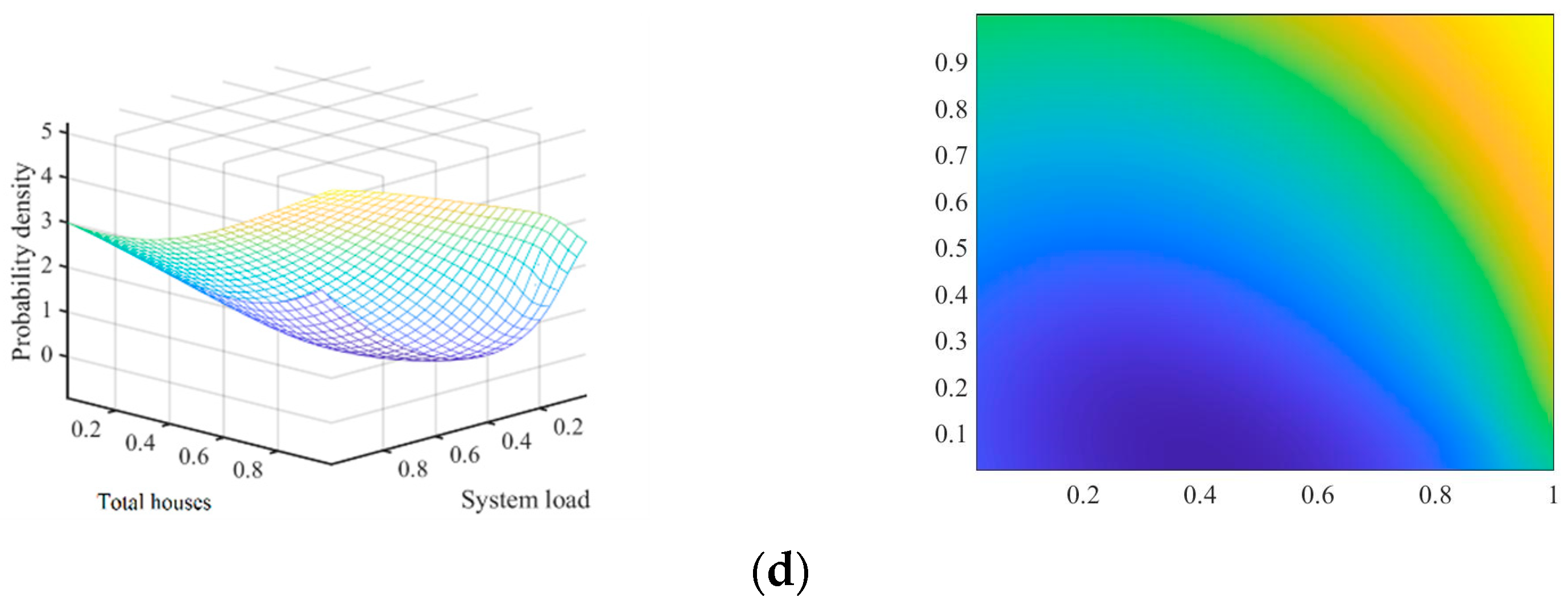
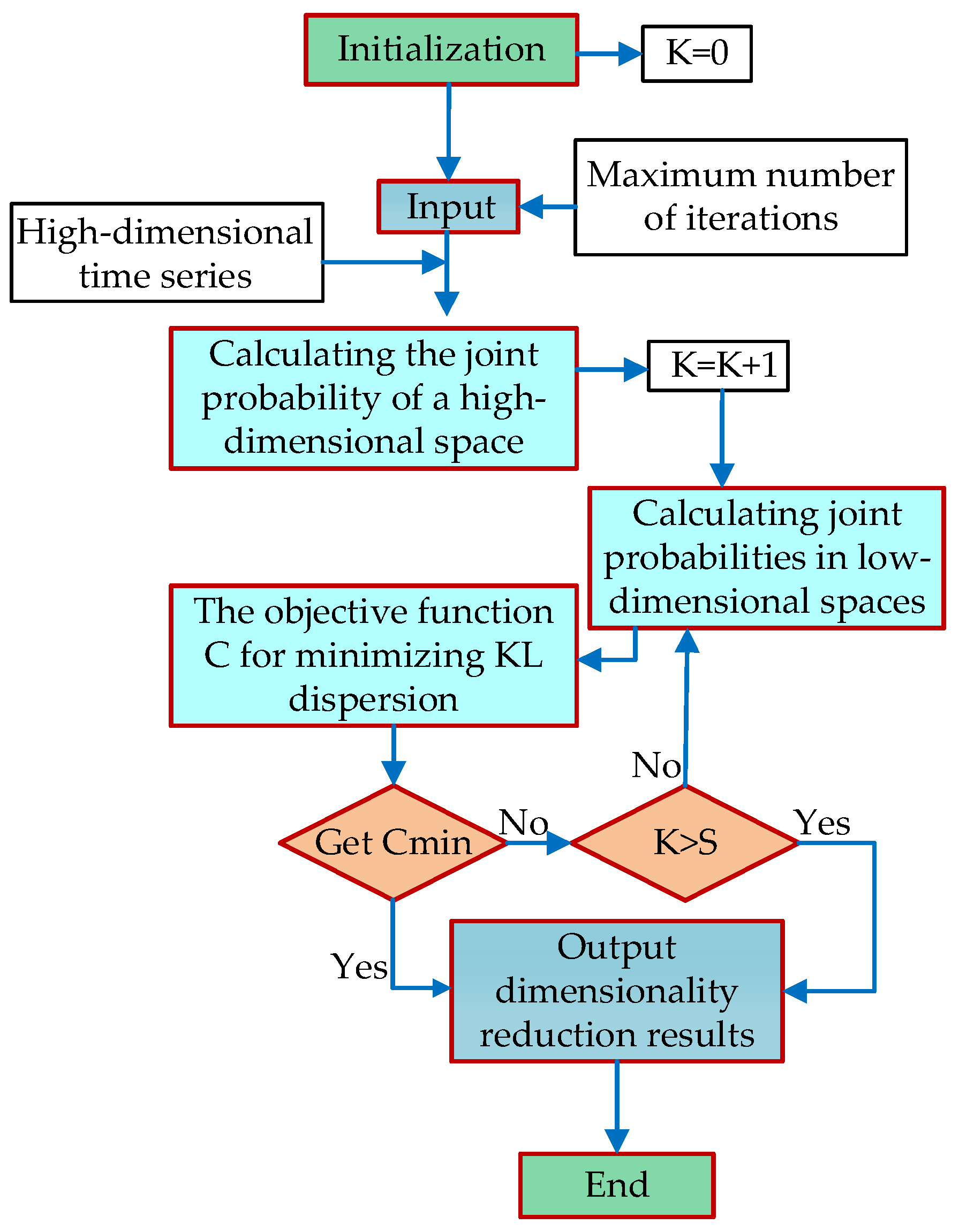
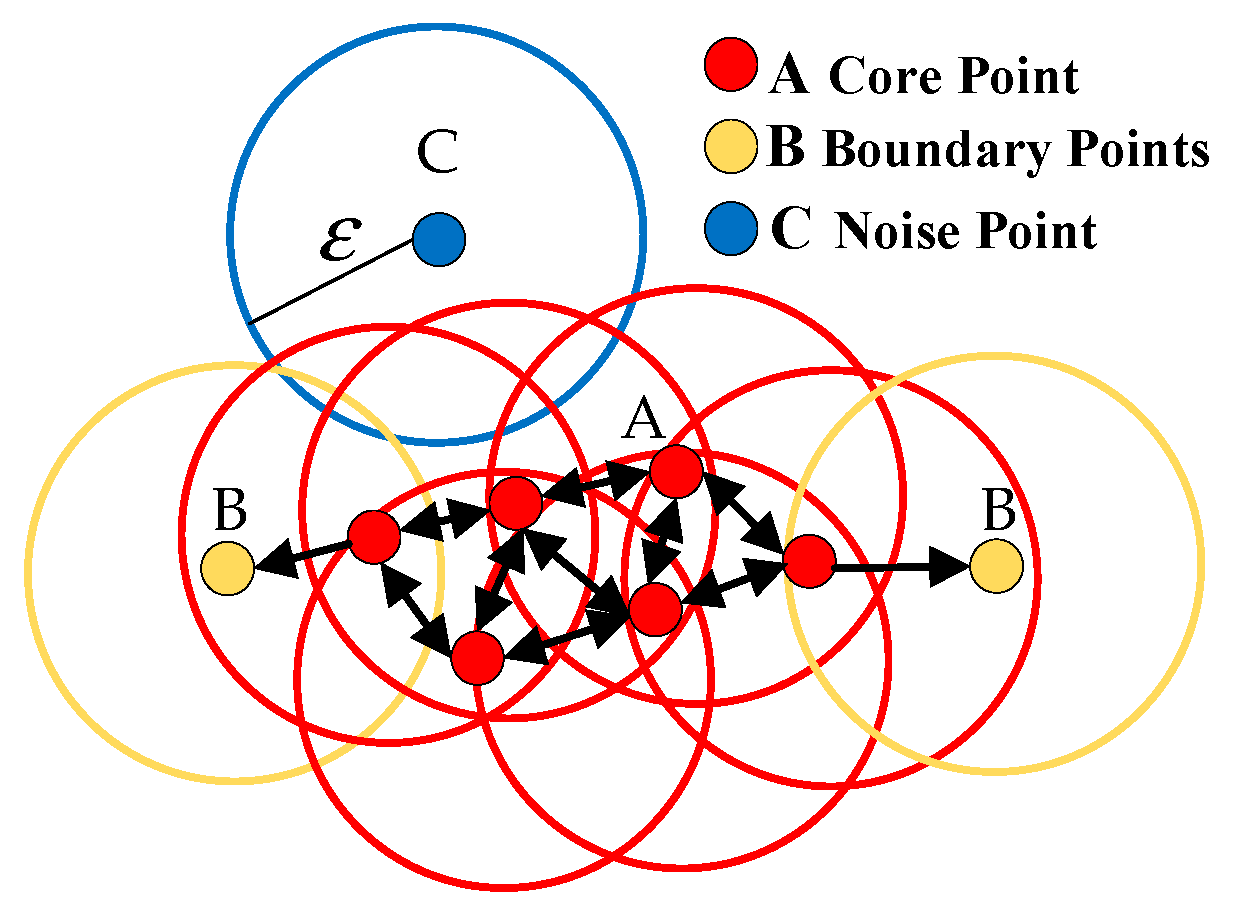


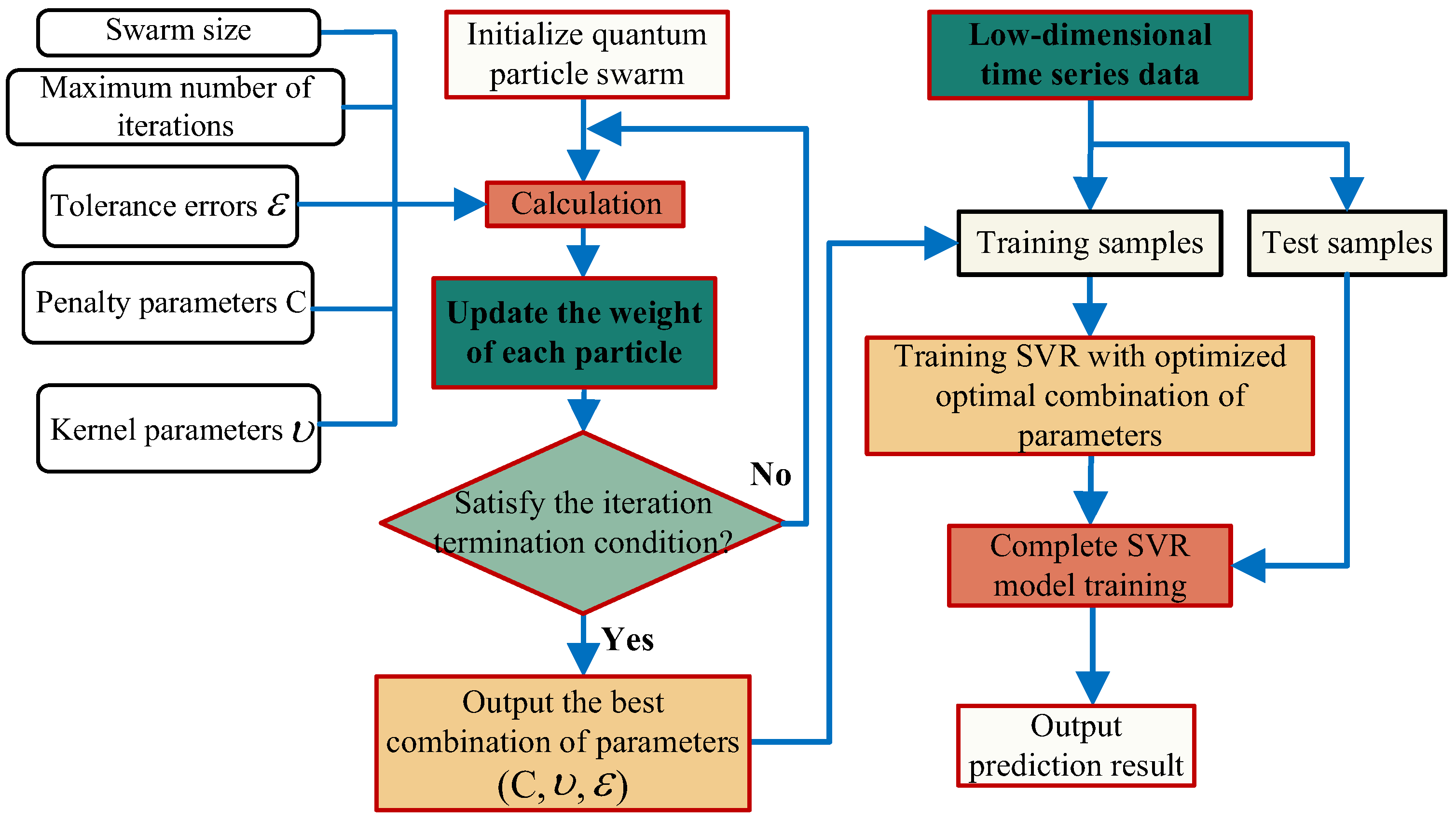
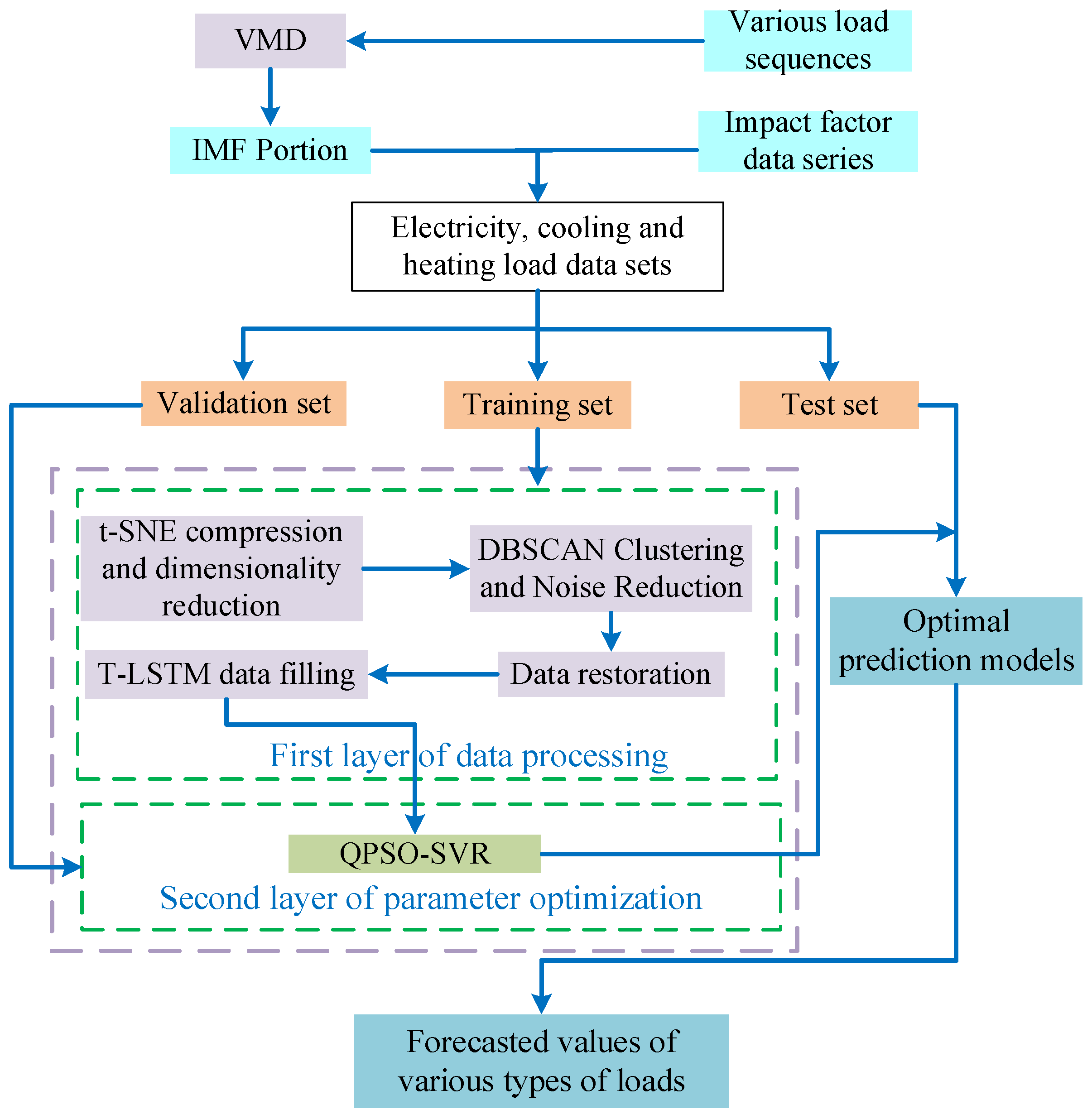
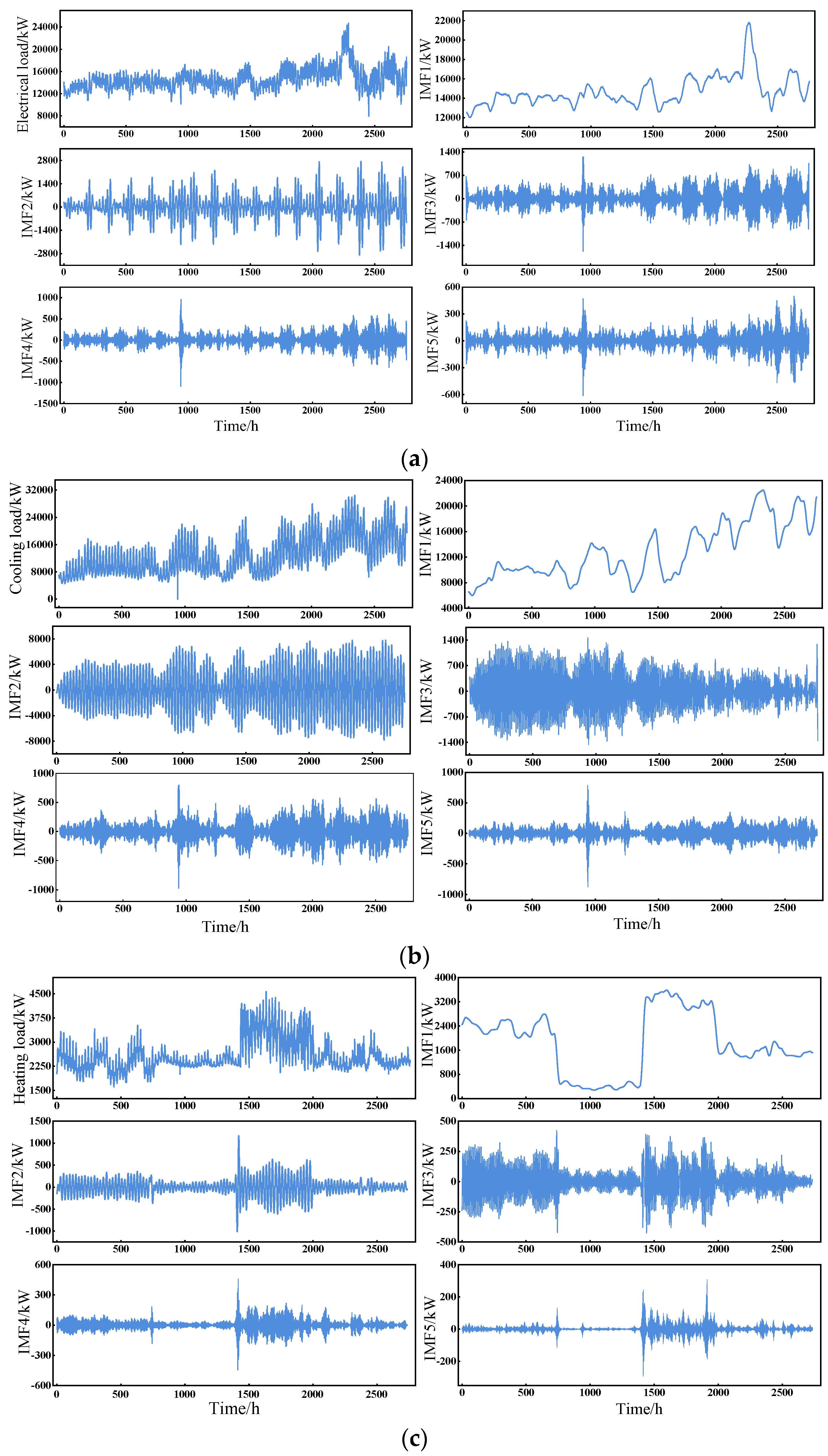
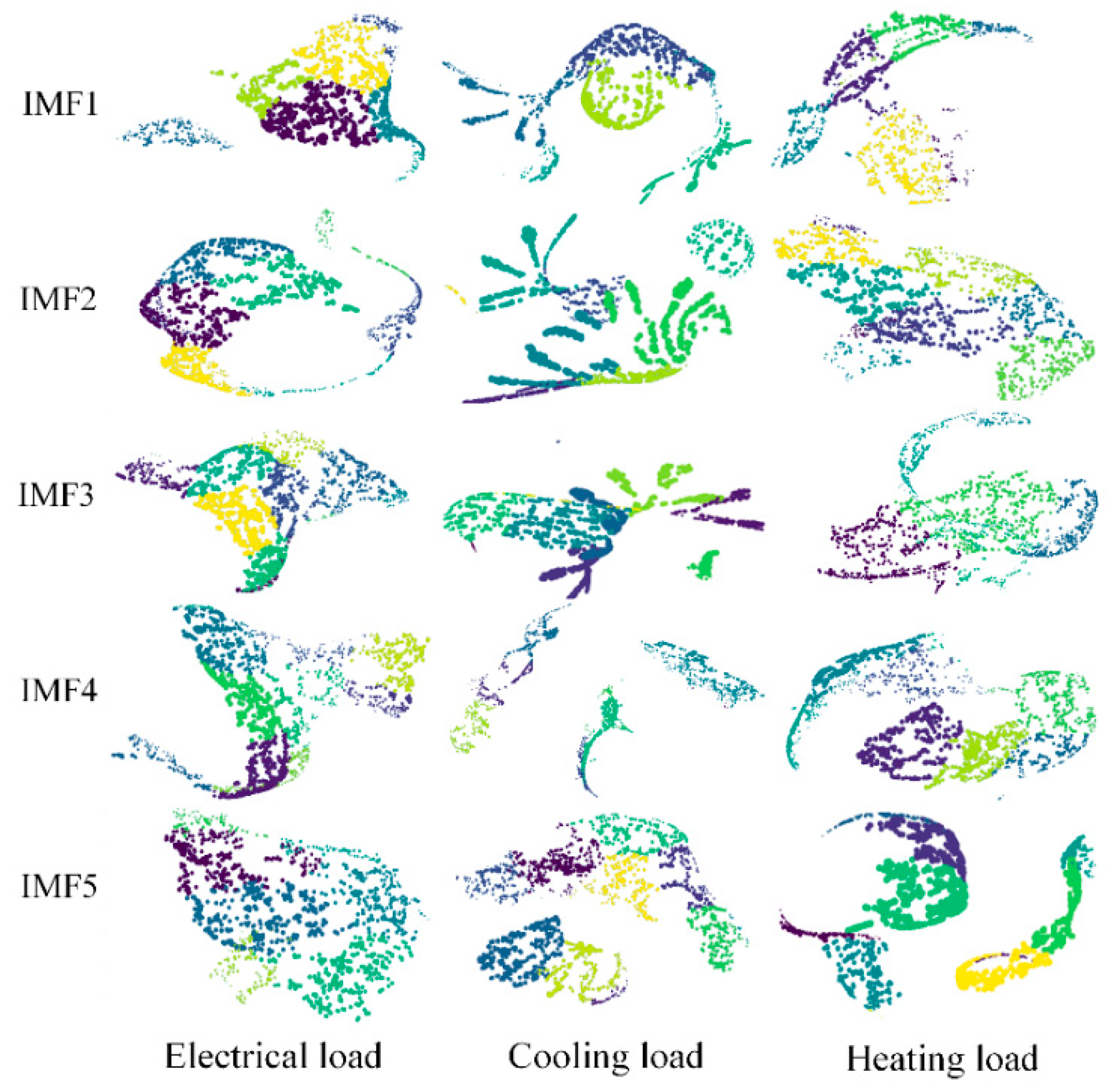
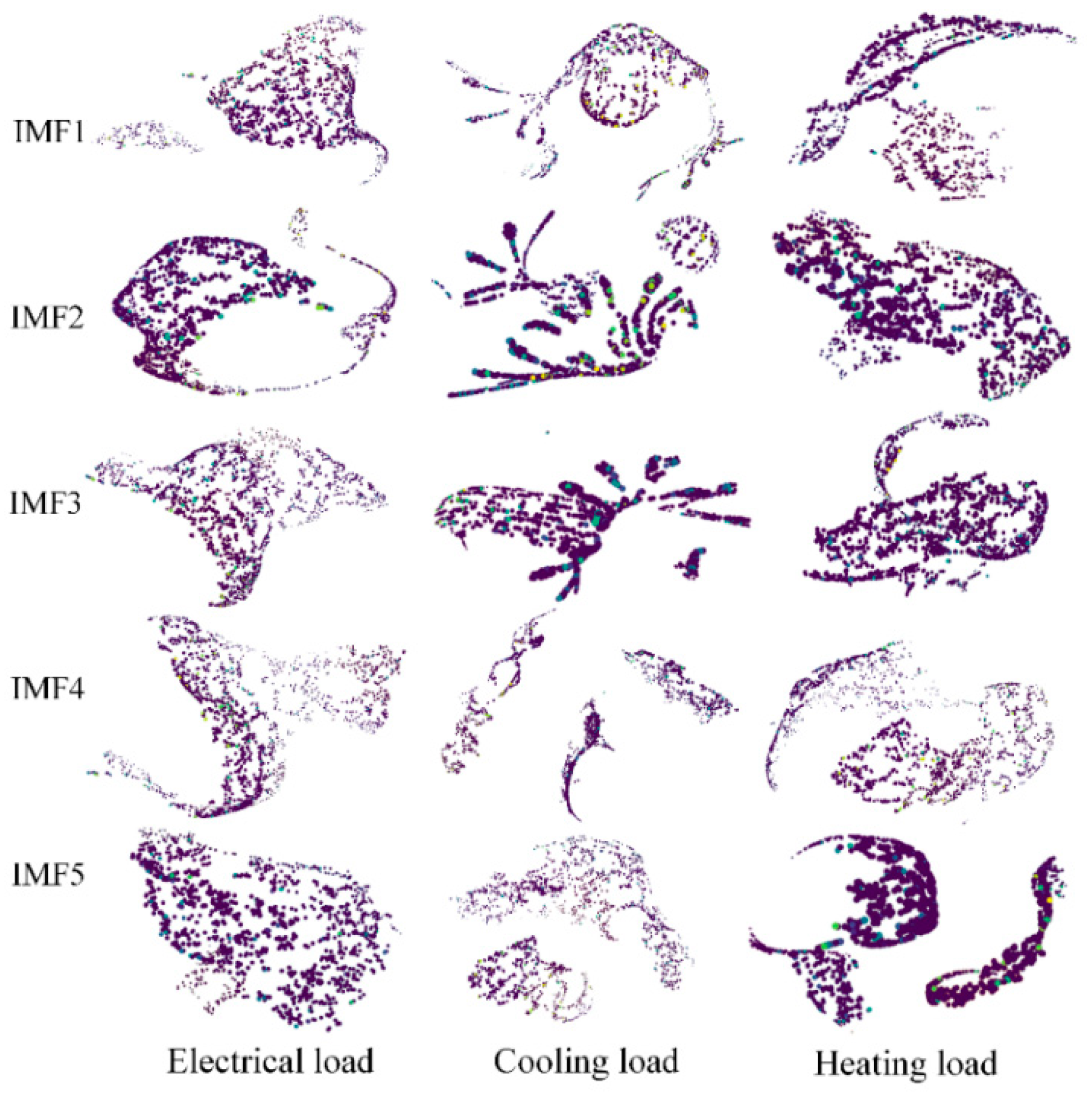
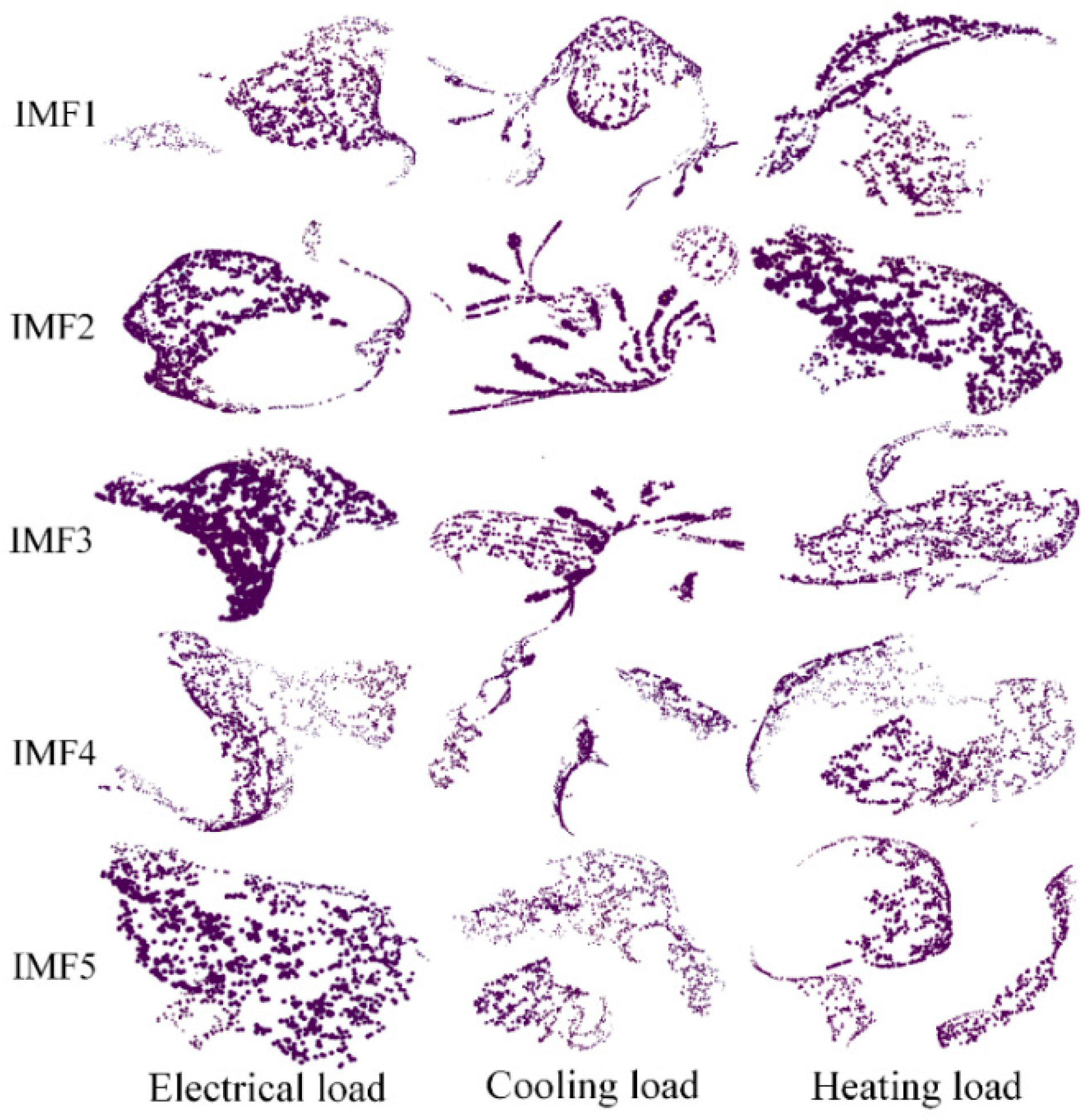

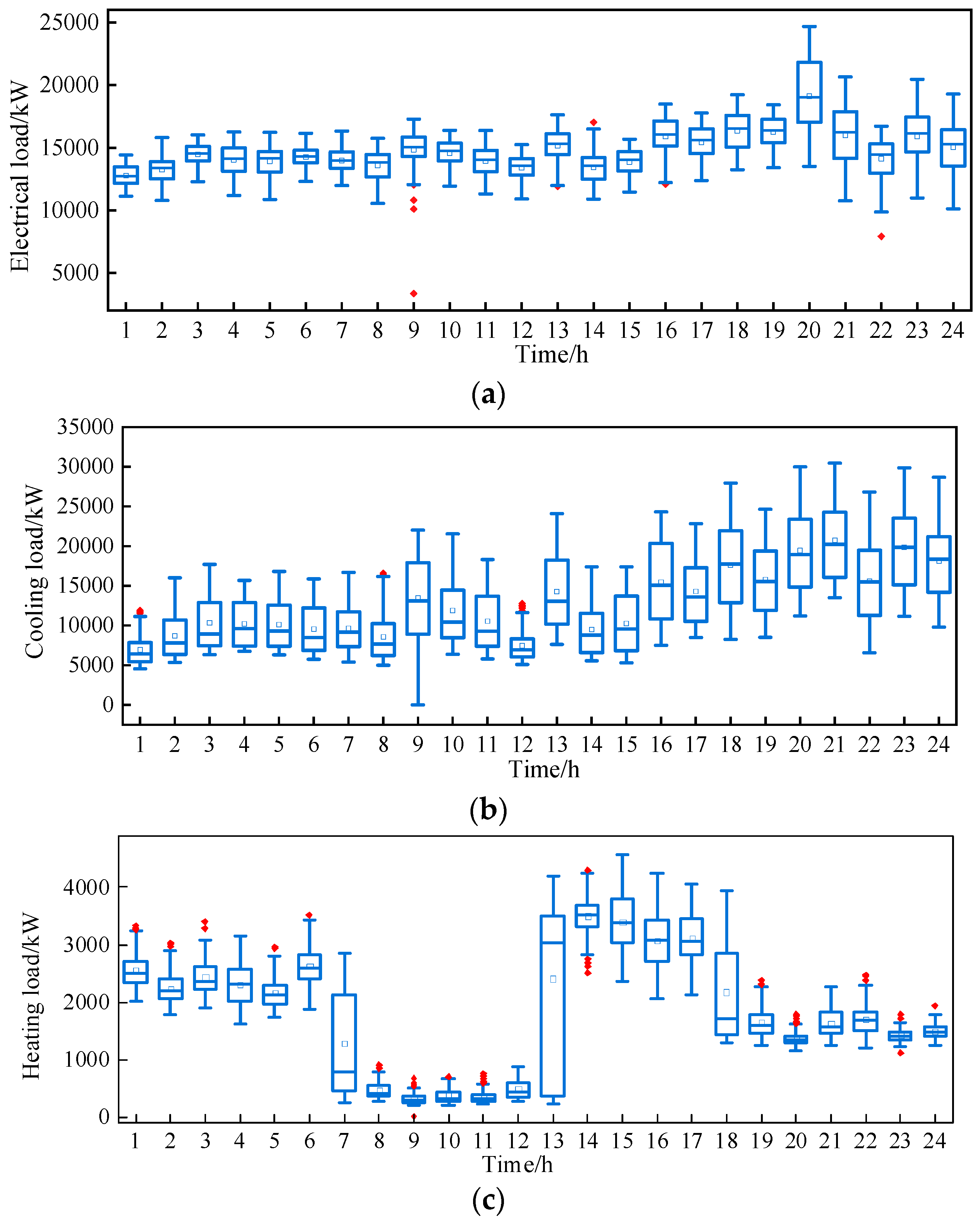

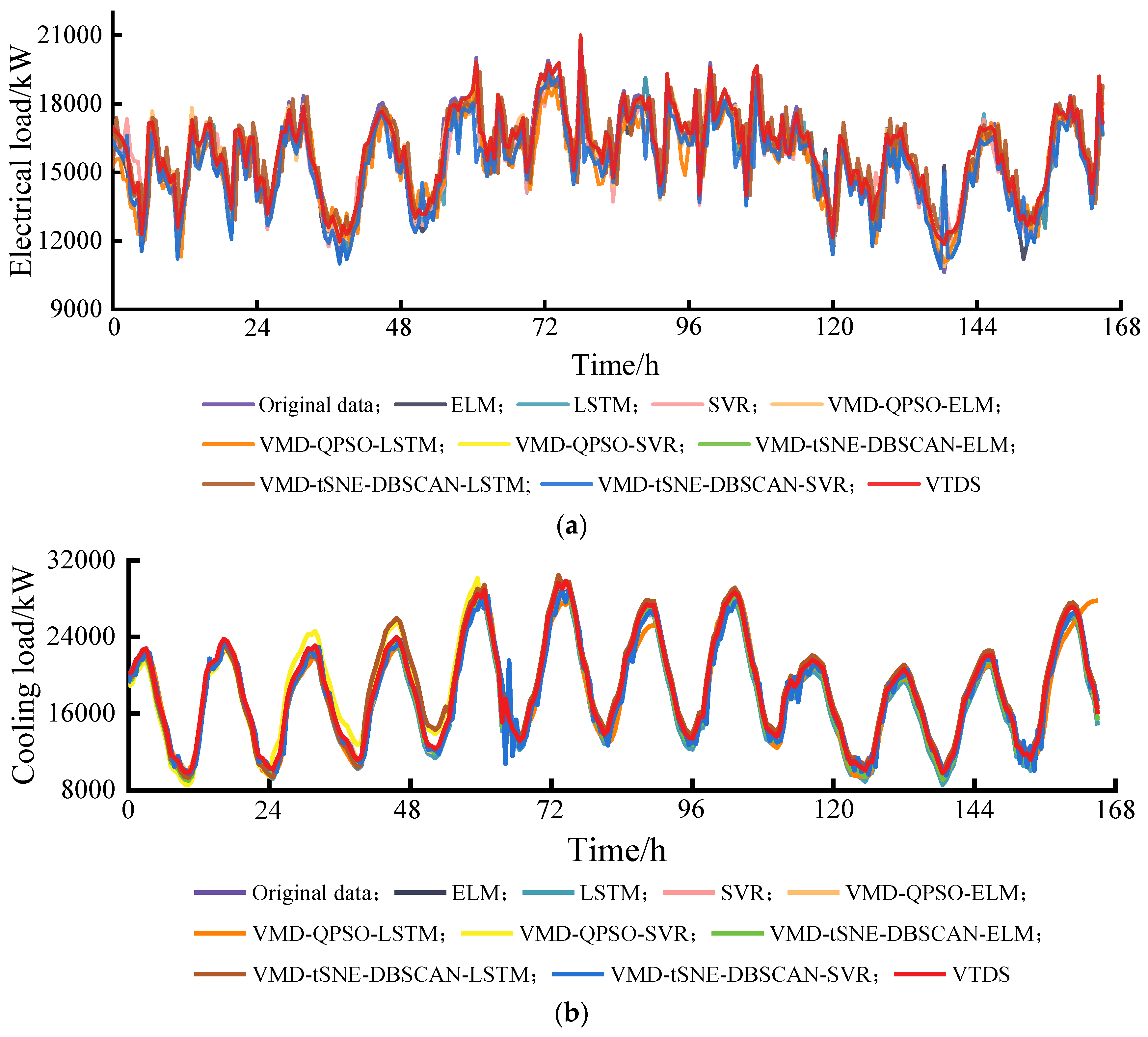
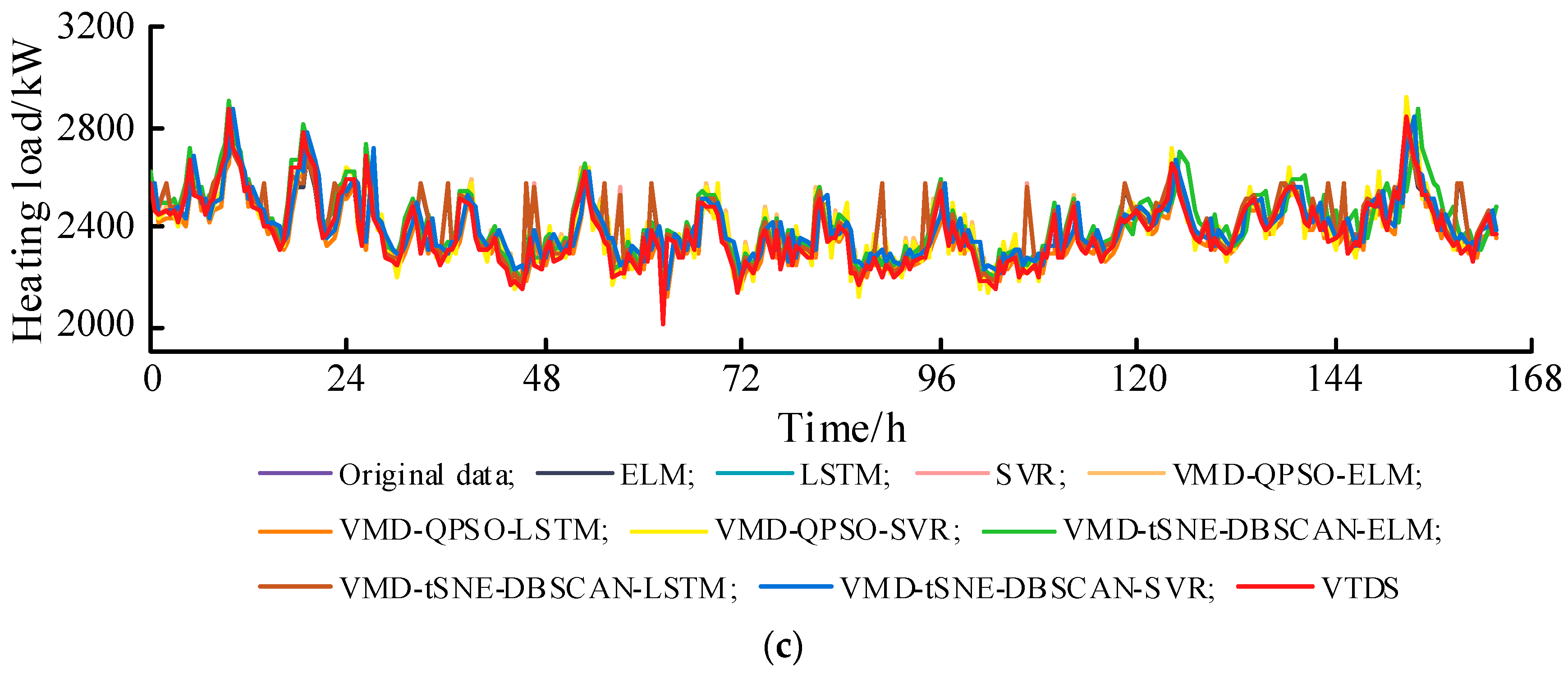
| Total Lightbulbs | Temperature | Greenhouse Gases | Total Houses | System Load | |
|---|---|---|---|---|---|
| Total lightbulbs | 1.00 | 0.58 | 0.91 | −0.37 | 0.30 |
| Temperature | 0.58 | 1.00 | 0.89 | 0.32 | −0.11 |
| Greenhouse gases | 0.91 | 0.89 | 1.00 | 0.10 | −0.05 |
| Total houses | −0.37 | 0.32 | 0.10 | 1.00 | −0.39 |
| System load | 0.30 | −0.11 | −0.05 | −0.39 | 1.00 |
| Type of Load | Principal Component Contribution Rate | Descending Order |
|---|---|---|
| Electrical load | [0.424 0.264 0.249 0.063] | 3 |
| Cooling load | [0.467 0.254 0.181 0.101] | 4 |
| Heating load | [0.329 0.271 0.214 0.186] | 4 |
| Model | RMSE (Electrical/Cooling/Heating Load)/kW | Average RMSE/kW |
|---|---|---|
| ELM | 618.3691/334.4753/346.5641 | 320.7622 |
| LSTM | 222.5678/415.8794/323.8393 | 433.1362 |
| SVR | 129.5528/216.5282/415.9774 | 330.5371 |
| VMD-QPSO-ELM | 228.7588/112.6572/530.8932 | 290.7697 |
| VMD-QPSO-LSTM | 314.8551/420.1306/244.2783 | 326.4213 |
| VMD-QPSO-SVR | 225.9870/417.5440/323.2073 | 322.2461 |
| VMD-tSNE-DBSCAN-ELM | 317.8189/228.3949/120.6046 | 222.2728 |
| VMD-tSNE-DBSCAN-LSTM | 429.0997/216.4032/332.6854 | 326.0628 |
| VMD-tSNE-DBSCAN-SVR | 212.1085/119.8910/97.0682 | 143.0226 |
| VTDS | 33.2324/46.2816/54.3692 | 44.6277 |
| Model | MAE (Electrical/Cooling/Heating Load)/kW | R2 (Electrical/Cooling/Heating Load) |
|---|---|---|
| ELM | 541.7383/425.3627/338.3464 | 0.8662/0.7892/0.8892 |
| LSTM | 531.0237/764.9110/372.9475 | 0.5990/0.7254/0.6301 |
| SVR | 339.1482/446.1584/529.1694 | 0.5770/0.8946/0.8634 |
| VMD-QPSO-ELM | 445.4997/556.9743/637.0386 | 0.8106/0.5366/0.7098 |
| VMD-QPSO-LSTM | 543.0011/626.4683/735.4365 | 0.9215/0.7500/0.8900 |
| VMD-QPSO-SVR | 435.7677/752.4003/848.5829 | 0.6799/0.6480/0.5736 |
| VMD-tSNE-DBSCAN-ELM | 643.3096/326.0979/438.5551 | 0.9607/0.7154/0.5366 |
| VMD-tSNE-DBSCAN-LSTM | 542.9419/354.1792/666.5641 | 0.4739/0.8201/0.7760 |
| VMD-tSNE-DBSCAN-SVR | 429.3462/233.4583/647.4392 | 0.9063/0.8950/0.9261 |
| VTDS | 64.4961/77.8533/86.5983 | 0.9906/0.9823/0.9657 |
Disclaimer/Publisher’s Note: The statements, opinions and data contained in all publications are solely those of the individual author(s) and contributor(s) and not of MDPI and/or the editor(s). MDPI and/or the editor(s) disclaim responsibility for any injury to people or property resulting from any ideas, methods, instructions or products referred to in the content. |
© 2023 by the authors. Licensee MDPI, Basel, Switzerland. This article is an open access article distributed under the terms and conditions of the Creative Commons Attribution (CC BY) license (https://creativecommons.org/licenses/by/4.0/).
Share and Cite
Lu, T.; Hou, S.; Xu, Y. Ultra-Short-Term Load Forecasting for Customer-Level Integrated Energy Systems Based on Composite VTDS Models. Processes 2023, 11, 2461. https://doi.org/10.3390/pr11082461
Lu T, Hou S, Xu Y. Ultra-Short-Term Load Forecasting for Customer-Level Integrated Energy Systems Based on Composite VTDS Models. Processes. 2023; 11(8):2461. https://doi.org/10.3390/pr11082461
Chicago/Turabian StyleLu, Tong, Sizu Hou, and Yan Xu. 2023. "Ultra-Short-Term Load Forecasting for Customer-Level Integrated Energy Systems Based on Composite VTDS Models" Processes 11, no. 8: 2461. https://doi.org/10.3390/pr11082461
APA StyleLu, T., Hou, S., & Xu, Y. (2023). Ultra-Short-Term Load Forecasting for Customer-Level Integrated Energy Systems Based on Composite VTDS Models. Processes, 11(8), 2461. https://doi.org/10.3390/pr11082461





